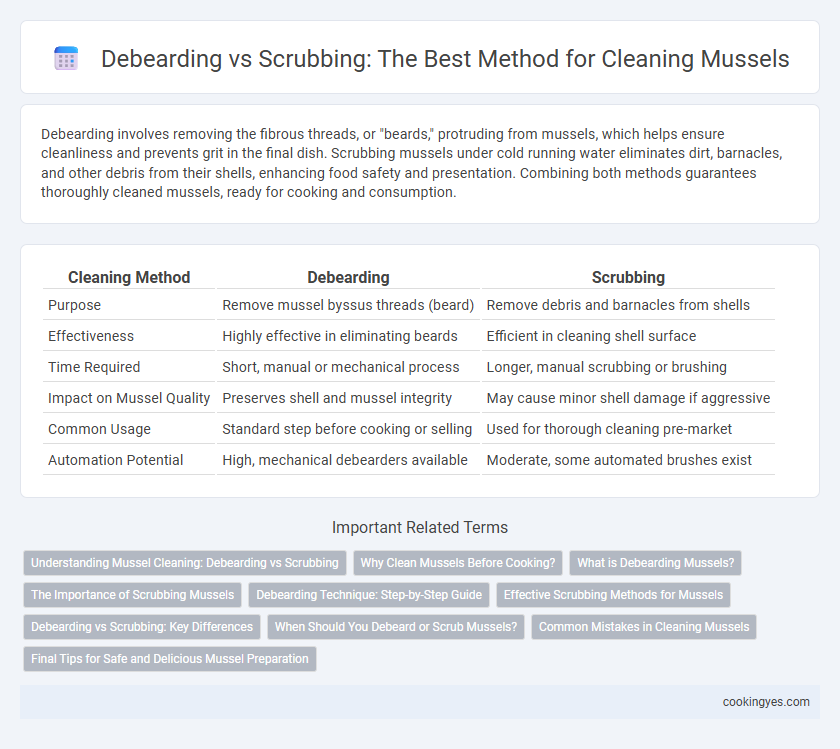Debearding involves removing the fibrous threads, or "beards," protruding from mussels, which helps ensure cleanliness and prevents grit in the final dish. Scrubbing mussels under cold running water eliminates dirt, barnacles, and other debris from their shells, enhancing food safety and presentation. Combining both methods guarantees thoroughly cleaned mussels, ready for cooking and consumption.
Table of Comparison
| Cleaning Method | Debearding | Scrubbing |
|---|---|---|
| Purpose | Remove mussel byssus threads (beard) | Remove debris and barnacles from shells |
| Effectiveness | Highly effective in eliminating beards | Efficient in cleaning shell surface |
| Time Required | Short, manual or mechanical process | Longer, manual scrubbing or brushing |
| Impact on Mussel Quality | Preserves shell and mussel integrity | May cause minor shell damage if aggressive |
| Common Usage | Standard step before cooking or selling | Used for thorough cleaning pre-market |
| Automation Potential | High, mechanical debearders available | Moderate, some automated brushes exist |
Understanding Mussel Cleaning: Debearding vs Scrubbing
Debearding mussels involves removing the fibrous byssal threads that mussels use to attach to surfaces, preventing grit and debris from contaminating the shellfish during cooking. Scrubbing mussels focuses on cleaning the outer shell to eliminate dirt, algae, and barnacles, enhancing both taste and safety. Proper cleaning requires combining debearding to avoid unpleasant textures and scrubbing to ensure shells are free from impurities before cooking.
Why Clean Mussels Before Cooking?
Cleaning mussels before cooking is essential to remove sand, grit, and debris that can affect texture and taste. Debearding eliminates the fibrous byssus threads, preventing an unpleasant chewy texture, while scrubbing removes barnacles and algae, ensuring a cleaner shell. Proper cleaning safeguards food safety and enhances the overall flavor of mussels in any seafood dish.
What is Debearding Mussels?
Debearding mussels involves removing the fibrous byssal threads, known as the beard, which mussels use to attach themselves to surfaces. This process is essential to ensure the mussels are clean and safe to eat, as the beard can harbor dirt and debris. Proper debearding enhances the mussels' freshness and tasting quality while simplifying the cooking process.
The Importance of Scrubbing Mussels
Scrubbing mussels is essential for removing barnacles, dirt, and algae clinging to their shells, ensuring cleaner and safer seafood consumption. Unlike debearding, which focuses on removing the byssal threads, scrubbing addresses external contaminants that affect both appearance and hygiene. Proper scrubbing preserves the mussel's natural flavor while preventing grit and unwanted residues from compromising the cooking process.
Debearding Technique: Step-by-Step Guide
Debearding mussels involves removing the fibrous byssal threads that attach them to surfaces, ensuring a cleaner taste and preventing grit in dishes. Begin by firmly grasping the beard near the shell and pulling it away with a quick, steady motion, avoiding excessive force to prevent shell damage. Rinse the mussels under cold running water afterward to wash away any remaining debris or loosened dirt.
Effective Scrubbing Methods for Mussels
Effective scrubbing methods for mussels involve using a stiff-bristled brush under cold running water to remove dirt, barnacles, and debris from the shells, enhancing their cleanliness and safety for consumption. Prior to scrubbing, debearding--or pulling out the fibrous byssal threads--is crucial for preventing grit and impurities during cooking. Proper scrubbing combined with debearding ensures mussels are thoroughly cleaned, maximizing freshness and reducing the risk of shellfish contamination.
Debearding vs Scrubbing: Key Differences
Debearding mussels involves removing the fibrous beard or byssus threads that mussels use to attach to surfaces, which is essential for preventing grit and ensuring cleanliness. Scrubbing focuses on cleaning the mussel shells by removing dirt, barnacles, and other debris from the outer surface to improve appearance and hygiene. The key difference lies in debearding targeting internal attachments, while scrubbing addresses external shell cleanliness.
When Should You Debeard or Scrub Mussels?
Debearding mussels is essential when the fibers, or beards, are still attached to the shells, as they can affect cooking and texture. Scrubbing is necessary when shells have visible dirt, barnacles, or debris to ensure cleanliness and safety. Mussels should be debearded before scrubbing to remove the tough byssal threads, followed by thorough scrubbing under cold running water to eliminate external contaminants.
Common Mistakes in Cleaning Mussels
Common mistakes in cleaning mussels include failing to remove the beard, which is the fibrous byssal threads, leading to an unpleasant texture when cooked. Many overlook thorough scrubbing of the shells to eliminate dirt, sand, and barnacles, compromising the mussel's flavor and safety. Neglecting to discard mussels with cracked shells or those that don't close when tapped increases the risk of foodborne illness.
Final Tips for Safe and Delicious Mussel Preparation
Debearding mussels by removing the fibrous beard prevents gritty texture and ensures cleaner shells, while scrubbing removes dirt and barnacles for improved taste. Always discard mussels that remain open after tapping to avoid foodborne illness. Rinsing mussels thoroughly under cold water and using fresh seafood guarantees a safe and flavorful dish.
Debearding vs Scrubbing for cleaning mussels Infographic

 cookingyes.com
cookingyes.com